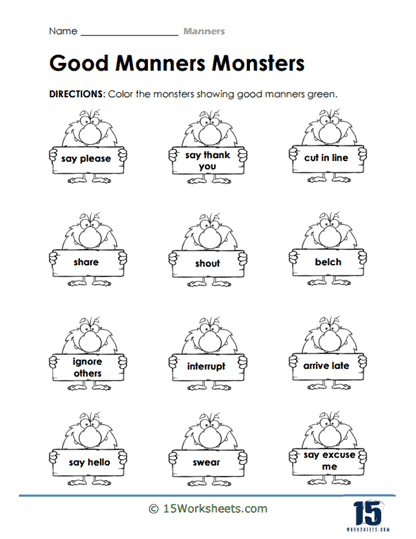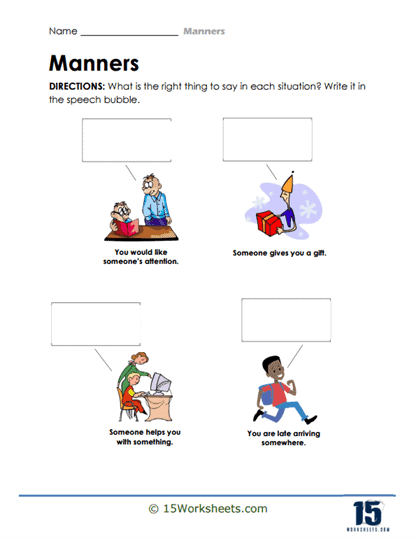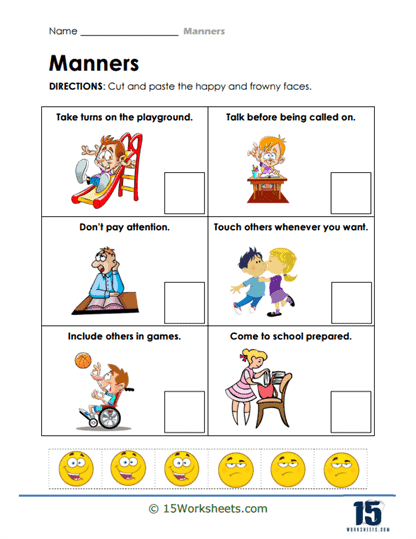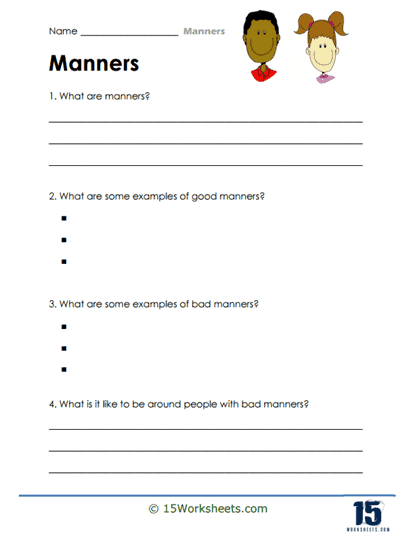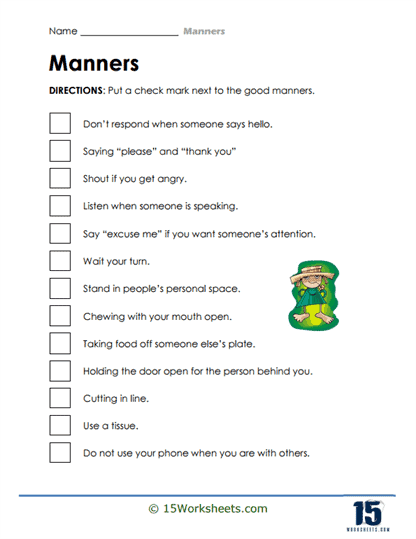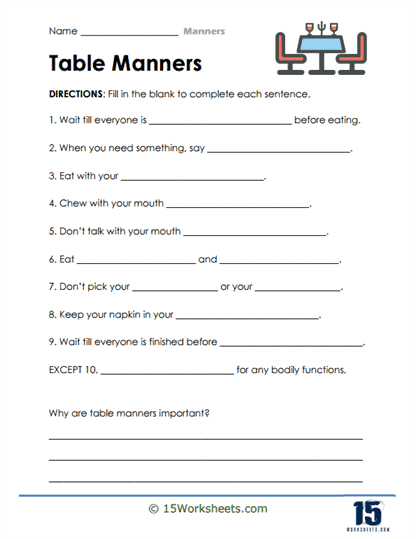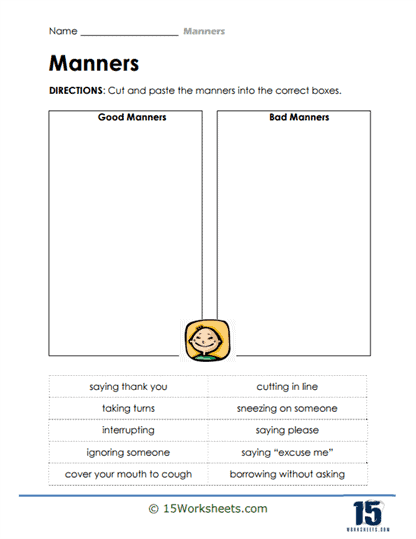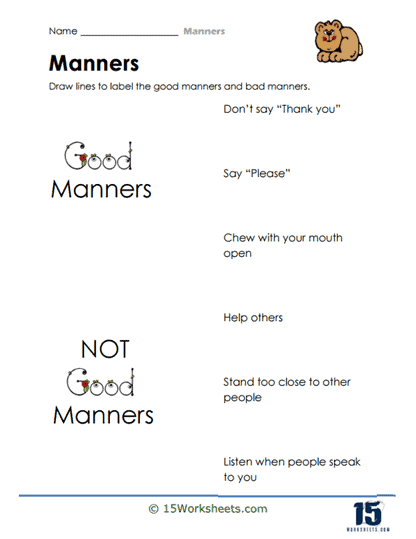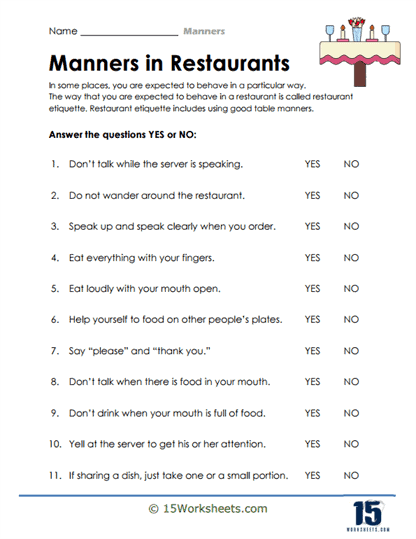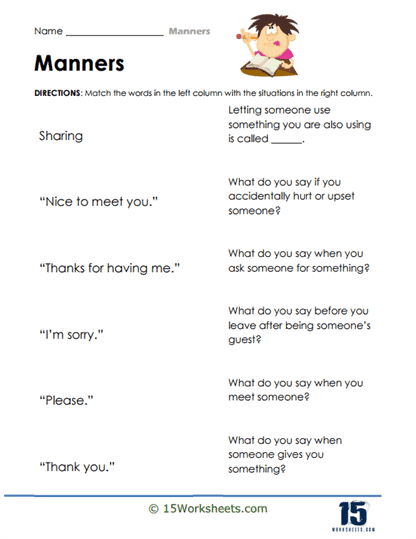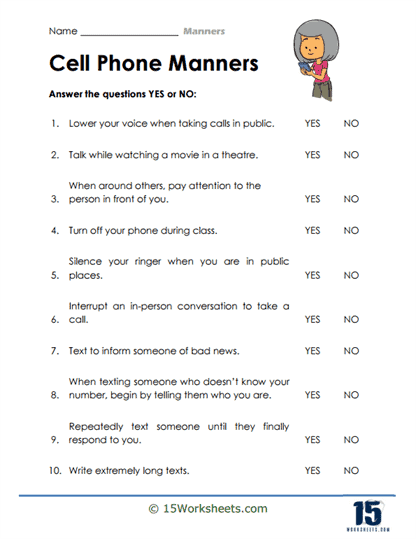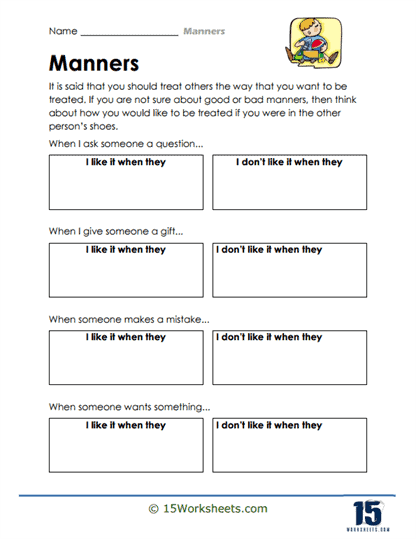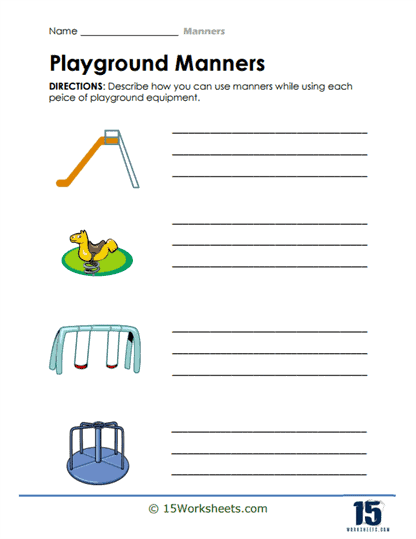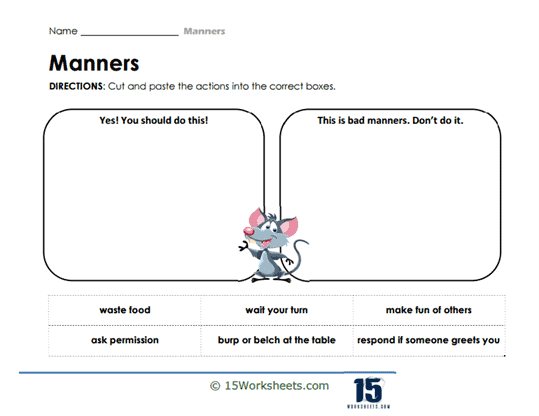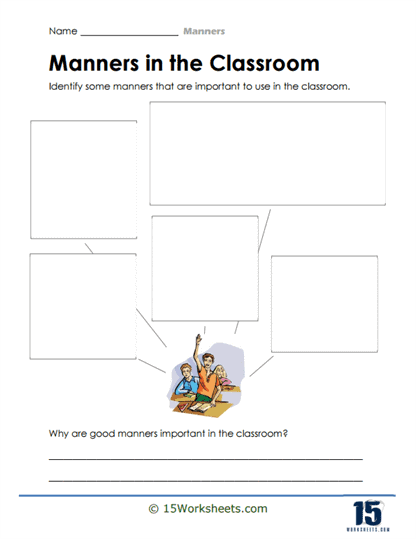Manners Worksheets
About These 15 Worksheets
The collection is a comprehensive set of educational tools designed to help students learn and practice good manners in a variety of settings. These worksheets are ideal for teachers, homeschoolers, and parents who want to instill essential social skills and etiquette in their students or children. The activities in this collection are crafted to be both engaging and instructive, providing students with practical examples and scenarios that illustrate the importance of polite behavior. With these worksheets, students will not only learn what good manners look like but also understand why they matter in everyday interactions.
One of the featured worksheets in this collection involves sorting different behaviors into “Good Manners” and “Bad Manners” categories. This cut-and-paste activity is designed to help younger students visually distinguish between behaviors that are polite and those that are not. By physically placing actions like “saying thank you” in the “Good Manners” box and “cutting in line” in the “Bad Manners” box, students engage in a hands-on learning experience that reinforces the concept of manners in a memorable way. This type of activity also encourages critical thinking as students must decide which actions belong in each category.
Another worksheet asks students to match behaviors with either a happy or a frowning face, indicating whether the behavior is appropriate or not. This activity is particularly useful for helping students understand the social consequences of their actions. For example, “Taking turns on the playground” is matched with a happy face, showing that such behavior is valued and appreciated, while “Talking before being called on” is matched with a frowning face, indicating that it disrupts the flow of the classroom. This visual representation helps students quickly grasp the concept of manners and how their actions can affect others.
The “Good Manners Monsters” worksheet adds a fun and creative twist to learning about manners. In this activity, students are asked to color in the monsters that are exhibiting good manners. For example, monsters holding signs that say “say please” or “share” should be colored green, while those holding signs with bad behaviors like “cut in line” or “belch” are left uncolored. This activity not only reinforces the idea of good behavior but also makes learning about manners enjoyable and engaging for younger students. The use of monsters adds an element of fun, making the lesson more appealing and less like a traditional lecture on etiquette.
Another practical worksheet in the collection prompts students to think about the appropriate responses in various social situations. For example, students might be asked to fill in speech bubbles with what they would say if someone gave them a gift or if they were late arriving somewhere. This activity encourages students to think on their feet and practice using polite language in real-life scenarios. It’s an excellent way to help students internalize the language of manners, ensuring that they are prepared to respond appropriately in different situations.
The collection also includes worksheets that address specific contexts, such as “Manners in Restaurants” and “Cell Phone Manners.” The “Manners in Restaurants” worksheet guides students through a series of yes-or-no questions about appropriate behavior in a dining setting. For example, questions like “Don’t talk while the server is speaking” or “Say ‘please’ and ‘thank you'” help students understand the expectations of good table manners. This worksheet is particularly useful for teaching students how to behave in public spaces, ensuring that they can dine out with respect and consideration for others.
“Cell Phone Manners” is another timely addition to the collection, addressing the challenges of modern technology in maintaining good manners. This worksheet presents scenarios such as “Lower your voice when taking calls in public” and “Silence your ringer when you are in public places,” asking students to indicate whether these behaviors are appropriate. This activity is especially relevant in today’s digital age, where the misuse of cell phones can easily lead to rude or disruptive behavior. By teaching students proper cell phone etiquette, this worksheet helps them navigate the complexities of modern communication with grace and respect.
In addition to these activities, you will also find exercises that encourage self-reflection. For instance, one worksheet asks students to think about how they would like to be treated in various situations, such as when they make a mistake or when they ask someone a question. By reflecting on their own preferences, students can better understand the importance of treating others with the same respect and consideration they desire. This type of introspective activity fosters empathy and helps students develop a more profound sense of social responsibility.
To ensure that learning about manners is not only educational but also creative, the collection features activities like drawing and storytelling. For example, students might be asked to draw a picture of themselves practicing good manners, such as holding the door open for someone or waiting their turn. This type of activity allows students to express their understanding of manners through art, making the lesson both engaging and personal. Storytelling exercises might involve writing a short story about a character who learns the importance of saying “please” and “thank you” or who discovers why it’s essential to listen when others are speaking.
This set also includes role-playing activities, where students can act out different scenarios that require good manners. This type of interactive learning is particularly effective in helping students practice what they have learned in a safe and supportive environment. Role-playing allows students to explore different responses to social situations and receive feedback on their behavior, making the lessons on manners more dynamic and impactful.
Available in PDF format, these worksheets are convenient to view, download, and print, making them an accessible resource for teachers and parents alike. By incorporating these worksheets into their curriculum, educators can help students develop the social skills necessary for positive interactions and successful relationships.
What Are Good Manners?
Good manners refer to behaviors and practices that demonstrate respect, kindness, and consideration for others. They encompass a wide range of social norms, from saying “please” and “thank you” to respecting personal space and listening attentively when others speak. Good manners are the foundation of positive interactions and relationships, helping individuals to navigate social situations smoothly and with grace. They are not just about following rules but about showing empathy and understanding toward others. Good manners are essential in fostering an environment where everyone feels valued and respected, making them a critical aspect of social development.
In essence, good manners are the outward expression of an individual’s character and values. They reflect an awareness of others’ feelings and a commitment to behaving in ways that promote harmony and mutual respect. Whether it’s holding the door open for someone, waiting your turn in a conversation, or using polite language, good manners help create a positive atmosphere in any setting. They are crucial not only in personal interactions but also in professional and public spaces, where respectful behavior is key to successful communication and collaboration.
Helping Students Learn Good Manners
Teachers play a vital role in instilling good manners in their students, as they are often the primary role models for behavior in a student’s life. The classroom is an ideal environment for teaching manners because it is a microcosm of society where students must learn to interact with peers and authority figures in a respectful and cooperative manner. Teachers can instill good manners by consistently modeling polite behavior, setting clear expectations for conduct, and reinforcing positive behaviors when they occur. By creating a classroom culture that values respect, kindness, and consideration, teachers can help students internalize these values and carry them into other areas of their lives.
One of the most effective ways teachers can instill good manners is through direct instruction and practice. This might involve specific lessons on what constitutes good manners, role-playing scenarios where students practice polite behavior, or integrating discussions about manners into everyday activities. For example, teachers can use moments when students interact with each other to highlight and praise examples of good manners, such as sharing, waiting their turn, or offering help to a classmate. Over time, these lessons become ingrained as students see the benefits of good manners in fostering positive relationships and a supportive classroom environment.
Consistent Reinforcement and Positive Reinforcement
Consistency is key when it comes to instilling good manners in students. Teachers must consistently reinforce the importance of manners by addressing both positive and negative behaviors as they arise. Positive reinforcement, such as praise, rewards, or recognition, can be particularly effective in encouraging students to practice good manners regularly. When students see that their polite behavior is noticed and appreciated, they are more likely to continue exhibiting those behaviors. Conversely, when negative behaviors are addressed calmly and constructively, students learn that there are social expectations for how they should treat others.
Teachers can also use various strategies to reinforce good manners over time. For example, they might implement a classroom reward system where students earn points or privileges for demonstrating good manners. Additionally, incorporating discussions about manners into other subject areas, such as literature or social studies, can help students see the relevance of polite behavior in different contexts. By making manners a consistent part of the classroom experience, teachers help students develop a deep-seated understanding of why good manners matter and how they can positively impact their interactions with others.
Instilling good manners in students has long-term benefits that extend beyond the classroom. Students who learn the importance of respectful behavior at a young age are more likely to carry those values into adulthood, contributing to their success in personal, academic, and professional settings. Good manners help individuals build strong relationships, navigate social challenges, and create positive impressions on others. Moreover, individuals who consistently practice good manners are often seen as more trustworthy, reliable, and considerate, traits that are highly valued in all areas of life.
Teachers play a crucial role in instilling these values in their students by modeling polite behavior, providing direct instruction, and creating a supportive environment. Through consistent reinforcement and positive reinforcement, teachers can help students internalize the importance of good manners and carry these behaviors into all areas of their lives. The long-term impact of teaching good manners is profound, as it contributes to the development of respectful, empathetic individuals who are well-equipped to navigate the complexities of social interactions and contribute positively to society.

